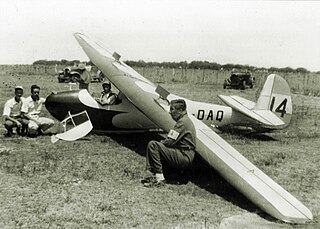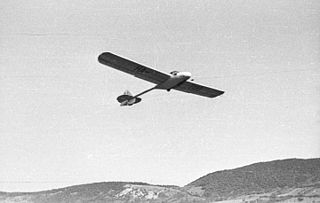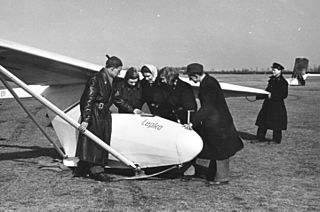
The Schleicher Rhönbussard, otherwise known as the DFS Rhönbussard was intended as an intermediate glider trainer which could also fly competitively. It was designed by Hans Jacobs in Germany in the early 1930s. More than 200 were built.

The Bonomi BS.7 Allievo Italia was a single seat, primary glider designed and built in Italy in the 1920s.
The Bonomi BS.16 Allievo Bonomi was a single seat primary glider, designed and built in Italy in 1930 and widely used by flying clubs.
The Teichfuss Allievo Pavullo was an Italian single seat open frame primary glider, designed by Luigi Teichfuss of Pavullo and first flown in 1940. It was sold in two versions, strut and cable braced. A single two seat variant was also built.

The RRG Falke of 1930 was a secondary training glider designed by Alexander Lippisch in Germany and intended to provide better performance than his earlier RRG Prüfling whilst being easier to fly because of its inherent stability. It was sold as plans for both club and commercial production and was built in Germany and abroad.

The Jacobs Hols der Teufel was a single seat trainer glider produced in complete and plan forms in Germany from 1928. It was built and used worldwide.

The Schleicher Poppenhausen named after the town of Poppenhausen was a two-seat glider, available as a dual control advanced trainer, produced in Germany from 1928.
The Schneider ESG 31 Schlesierland (Silesia) was a representative of a group of German, 16 m span, one-off gliders, built by Schneider in Grunau from 1929 to at least 1931.
The Schneider Grunau 8 was a simple, two-seat trainer glider designed and built in Germany in the early 1930s.
The Schneider ES49 is a two-seat glider trainer, designed, first flown in late August 1951 and commercially produced in Germany but later built from plans by gliding clubs in Australia. A major redesign there led to the ES49B Kangaroo.
The Musger Mg 9 was a tandem two seat glider built in Austria in the mid-1930s. It broke both world and national records.

The Caudron Type L was a two-seat French pusher configuration amphibious biplane, flown around 1913 and intended for naval use.

The Caproni Ca.95 was a large, three engine, long range, heavy bomber prototype built in Italy in 1929. It could carry a 1,600 kg (3,500 lb) bomb load and had three defensive gun positions. Only one was built.
The Bassou Rubis (Ruby) was a low power, robust French aircraft designed for basic training and touring.
The Aviad Zigolo MG12 is an Italian kitbuilt introductory motor-glider first flown in 2012. It has a small engine and limited gliding performance but is inexpensive to buy and run and simple to build and fly. Kit production began in 2013 and by the following year twenty had been sold.
The MSrE M-20 was a Hungarian primary glider with a better performance than the first generation of such aircraft. One of its designers was Ernő Rubik and the MSrE M-20 was his first major contribution. Only one was built.
The Lampisch LS-16 was a Hungarian training glider of mixed construction. It was flown but not granted a Certificate of Airworthiness.

The Rubik R-15 Koma (Godfather) was a side-by-side seat Hungarian training glider designed to introduce pilots to winch-launching techniques. A second, very similar but single seat design, the Rubik R-16 Lepke, provided follow-up solo experience of the same techniques. Pairs were widely used by Hungarian glider clubs post-war, with 65 of each produced.

The Rubik R-16 Lepke (Butterfly) was a single seat Hungarian training glider designed to follow the very similar but two seat Rubik R-15 Koma in a winch-launch training programme. The Lepke provided solo experience of the techniques learned with an instructor in an aircraft with similar handling characteristics. That done, the Lepke could be used as a standard trainer to take its pilot to C-certificate level. The pair were widely used by Hungarian glider clubs post-war, with sixty-five of each produced.
The Oškinis BRO-11 was a primary glider designed in the USSR. It was produced in large numbers from the 1950s.












